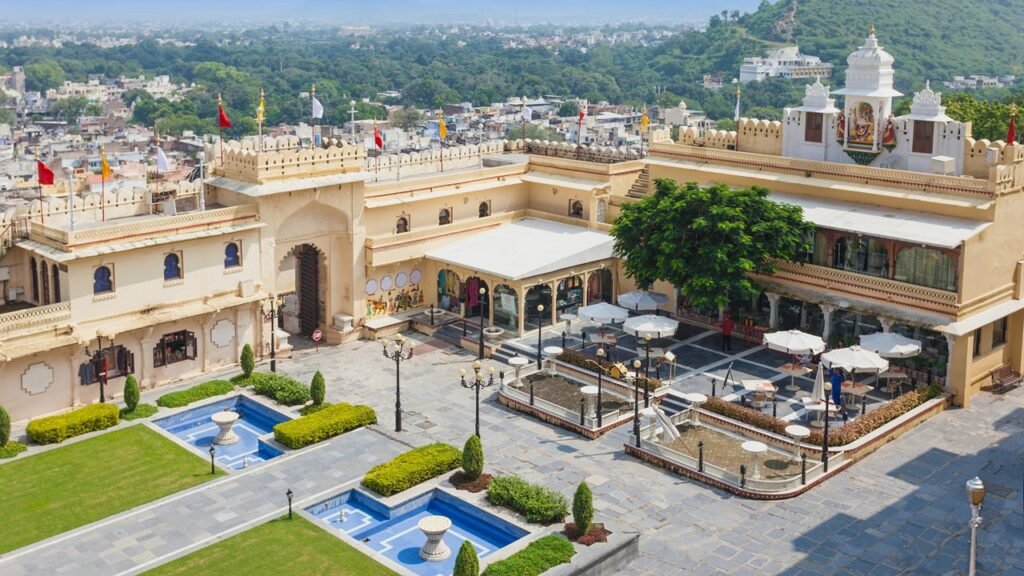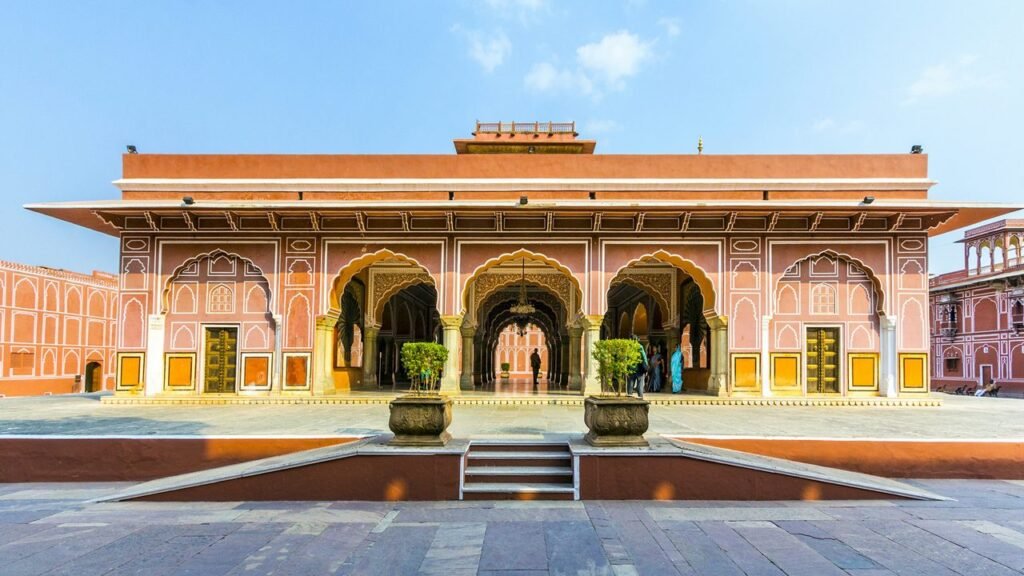The City Palace stands as an iconic testament to India’s regal heritage, renowned for its breathtaking architecture, vibrant culture, and fascinating royal history. Serving as both a living royal residence and a mesmerising tourist spot, City Palace in Jaipur and Udaipur attracts millions annually.
The City Palace is one of Rajasthan’s most celebrated landmarks, dazzling travellers with its Rajput-Mughal architecture, vibrant art collections, royal gardens, and living heritage. Situated at the heart of both Jaipur and Udaipur, the palace complex forms the backbone of Rajasthan’s cultural and tourist legacy, hosting grand festivals, historical exhibitions, and exclusive events.
Location and Route
Jaipur City Palace
- Located at the heart of Jaipur, the palace is easily accessible from many points in the city.
- Distance: 12 km from Jaipur Airport, 4.5 km from Jaipur Railway Station.
- By Road: Taxis, local buses, and rickshaws are available throughout Jaipur.
- By Metro: Chandpole Metro Station, 1.9 km away, connects the palace via auto-rickshaw or a brief walk.
Udaipur City Palace
- Situated on the banks of Lake Pichola, City Palace Udaipur is no less picturesque.
- Distance: Accessible from Udaipur Airport (~22 km) and Railway Station (~2 km).
Visitors can plan their journey via air, train, or road, with numerous transportation options making these locations well-connected and tourist-friendly.
Key Details:
History of City Palace
City Palace Jaipur was constructed between 1727 and 1732 by Maharaja Sawai Jai Singh II, founder of Jaipur and visionary ruler who sought a new capital for his growing kingdom. Designed by Indian architect Vidyadhar Bhattacharya, with later influences from European architect Samuel Swinton Jacob, the palace brought together Rajput, Mughal, and European architectural styles.
In contrast, City Palace Udaipur was established in 1559 by Maharana Udai Singh II as part of his new capital, following the fall of Chittorgarh and a vision guided by a local hermit. Over four centuries, successive Mewar rulers expanded it into a palatial marvel overlooking Lake Pichola.
Both palaces became central seats for administrative affairs, royal rituals, and celebrations, embodying power, wealth, and artistic patronage.
Cultural Heritage and Significance
The City Palace is far more than an architectural wonder; it is a living repository of Rajasthani culture and tradition. The complex features museums displaying royal costumes, weaponry, and artefacts, grand courtyards for festivals, and intricate frescos depicting centuries of history. The fusion of Rajput and Mughal design, coupled with elements of European architecture, illustrates Rajasthan’s rich cultural tapestry.
Annual cultural events, including Holi and Diwali celebrations, folk music performances, and curated art exhibitions, add to the living charm of City Palace. The textiles gallery in Mubarak Mahal, for example, offers a peek into age-old craftsmanship and royal attire.
Tourist Attraction
City Palace is among Rajasthan’s top tourist draws, mixing historical and luxury experiences. Tourists can witness:
- Opulent halls and courtyards such as Mubarak Mahal, Chandra Mahal, and Mor Chowk.
- Art galleries with ancient paintings, textiles, and royal artefacts.
- Ornate gates and walls, including the beautifully decorated Pritam Niwas Chowk.
- Light and sound shows, exclusive guided tours, and royal festivals.
Seasonal visits are advisable, with October to March offering the most pleasant weather and fewer crowds. Entry fees vary, generally around Rs 300 for adults, with special charges for museum galleries and guided tours.
Revenue and Royal Legacy
The City Palace has evolved into a sustainable heritage enterprise, with the Jaipur royal family earning millions through heritage tourism, museums, and events. Its business empire reportedly is worth thousands of crores, securing the family’s place among the wealthiest Indian dynasties.
Museum tickets, guided experiences, destination weddings, luxury hotel stays, and exclusive cultural events all contribute to its annual revenue. Guided tours and curated experiences are also a significant part of the business model.

Architectural Features
The palace complexes exemplify grandeur with marble and granite constructions, mirror and glass inlay work, colourful stained glass windows, and exquisite frescoes. Major features include:
- Mubarak Mahal: Display of textiles, European and Mughal influences.
- Chandra Mahal: Royal residence and museum with personal artefacts.
- Mor Chowk: Famous for its glasswork and peacock motifs.
- Kanch ki Burj: The Mirror Tower with ornate Rajasthani glass inlay, main attraction of Udaipur Palace.
- Moti Mahal and Manak Mahal: Private chambers featuring exceptional decor, precious stones, and family insignia.
Current News and Royal Disputes
Recent headlines captured the City Palace in Udaipur reopening after resolving a royal coronation dispute that closed its gates for four days. This event re-energized interest in the region’s royal heritage, with intricate rituals and family feuds making national news.
FAQs About City Palace
What is City Palace famous for?
City Palace is renowned for its royal architecture, rich history, and collection of artefacts, making it a top Rajasthan tourist destination.
Can the public visit the City Palace?
Yes, visitors can explore most portions of the palace, including museums, gardens, and some ceremonial halls. Guided tours are available.
What are City Palace opening hours?
The palace is generally open from 9:30 AM to 5:00 PM, with special shows and tours available in the evenings in Jaipur.
How do I reach City Palace?
In Jaipur, it is easily reached by road, metro, and railway, while Udaipur has similar transport options from the city’s airport and train station.
What are the entry charges for City Palace?
Adult tickets for general entry cost around Rs 300, with higher charges for museum galleries and guided experiences; children pay roughly half.
Do any royal families still live in City Palace?
Yes, parts of the palace still serve as royal residences for the Jaipur and Udaipur royal families.
What is the best time to visit City Palace?
The cooler months from October to March are advisable, with mornings and late afternoons preferred for exploration.
Conclusion
The City Palace’s grandeur and living heritage continue to enchant and inspire, serving not only as a beacon for Rajasthan’s regal past but also as a thriving cultural, economic, and tourism hub. Whether marvelling at its intricate architecture, exploring royal museums, or attending festivals, a visit to City Palace promises an unforgettable journey through the heart of India’s royal history.
